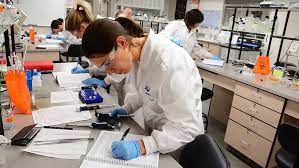This assignment is a 2000-word clinical update on the topic below:
Influenza Virus
It is strongly suggested you use the following section headings for your
update. You can use other headings if you wish but ensure you cover the
following areas in a clear manner:
1.Introduction
2.Aetiology & pathogenesis
3.Clinical manifestations
4.Diagnostic process
5.Treatment
6.Conclusion
7.References
NSC6101 Nursing Bioscience Assignment-Edith Cowan University Australia.

Please refer to the Clinical Update Information and Rubric 2021.1 in BB for
guidance.
- Types of influenza viruses; how it can change; “Drift” and “Shift”
- Current situation Australia and worldwide
- What strategies are in place (relate to pathophysiology)?
- Who is responsible for these strategies and monitoring their effect?
- How are vaccines shown to be safe?
- How do vaccines affect immunity?
- Make it concise, succinct… short, sharp sentences, don’t waffle!
- Write everything in the third person, no I’s, You’s or We’s…
- Assume you are an RN informing other RNs, so use language health professionals would use, not mums and dads.
- Assume RNs know basic anatomy and physiology
- Use best evidence and practice, using recent sources
- Do not use mum and dad websites such as e Medicine, Mayo Clinic, Better Health Channel, etc. or any website that does not cite their sources in the text of their pages.
- Write according to the marking rubric, apportion time accordingly
- Use figures, graphs and tables
- Ensure you link these with text, eg. “Some explanation…(see figure 1)”
- A table from only one source is not your own table, therefore not your own work and wont get any marks. All tables must have two or more sources to be your own work.
- Legends should be before tables and after figures, with sources cited.
- Words in tables will be included in the word count.
- Please see the SNM Assignment Guidelines
- Word count (+/- 10%) includes all text except reference list, contents page or appendices
- No direct quotes or appendices, they have no place in an update
- References at end of sentence (scientific), not references at start of sentence (essay style), eg. “…showed no difference (Gibson, 2017)” rather than “Gibson (2017) showed no difference…”
- Expected 10-15 references, <= 7 years old, peer-reviewed preferably
- Beware websites as references; most are meant for mums and dads
- End references can be single spaced, not doubled spaced as per APA. Use Endnote if available.
NSC6101 Nursing Bioscience Assignment-Edith Cowan University Australia.

Plagiarism: presenting other people’s work as your own without attributing it (ie, referencing) correctly.
Plagiarism checklist
- Have you enclosed all direct quotes in quotation marks and supplied the in-text reference?
- Have you supplied in-text references for all ideas that you’ve paraphrased?
- Have you supplied in-text references for sources you have consulted to support your ideas?
- Have you included all sources you’ve cited in your reference list?
- Have you correctly formatted all your references?
Paraphrasing is not:
- Changing just a word or two in someone else’s sentence
- Changing the sentence structure while maintaining the original words
- Substituting a few words with synonyms
NSC6101 Nursing Bioscience Assignment-Edith Cowan University Australia.

Paraphrasing is:
- Reading the source carefully and get the main idea of the author
- Writing notes to capture the idea without looking at the source text
- Inserting the in-text reference into your notes (cite all sources)
- Analysing, revising and relating the idea to those expressed by others
- Look at the Academic Skills Centre on BB
- They have Academic Skills Workshops and Assignment Drop-in Sessions, check the schedules and go to one!
- There is also P2P HQ every weekday in the libraries
- You can also make an appointment to see an academic learning advisor or librarian… details in BB
- There are plenty of resources available, no excuses!
- If you haven’t started yet, get started now
- Keep the assignment guidelines, APA referencing guide and the marking rubric nearby and refer to them constantly
- Don’t waffle… keep it short, clear, concise, succinct. Look at the exemplars provided.
- Only include what another RN would need to know: most updated evidence, best practice,nursing implications
- Do this, and it will be a great clinical update!
Excellent Assignment Help
We Aim At:
- Lowest Price.
- 100% Uniqueness.
- Assignment Fastest Delivery.
